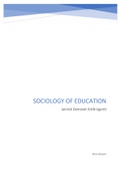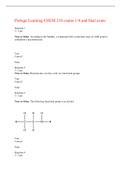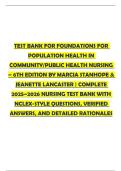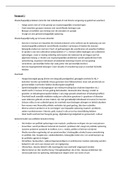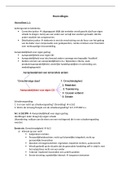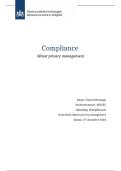Jannick Demanet (VUB-Ugent)
Elisa Breyne
, SOCIOLOGY OF EDUCATION
Contents
Class 1- A theoretical GPD................................................................................................................................................. 2
Class 3: socialization........................................................................................................................................................ 13
Class 4- Selection............................................................................................................................................................. 19
Class 5: Immigration, ethnic minorities and education .................................................................................................. 26
Class 6- Gender and education ....................................................................................................................................... 34
Class 7 : Education and LGBTQ+ youth ........................................................................................................................... 43
Class 8: School effectiveness research tradition: Does the school matter? ................................................................... 48
Class 9 Teachers throwing in the towel .......................................................................................................................... 55
Class 10: Pygmalion effects and classroom management .............................................................................................. 64
2 essays + Exam: written exam→open book for open questions (cases, comparisons, reflections)
Application, argumentation, defense
1
,Class 1- A theoretical GPD
To keep in mind with the theories and applications
I- Setting the scene
• Education?
o = learning, teaching
→ Socialisation
o Informal vs formal
→ Here focus on ‘Schooling’: not about any type of socialization
not focus on the school of hard knocks saying that sometimes something works and sometimes it doesn’t
<->education of sociology: about the sociology of educating- how do you teach well
Sociology of education: about the institution of education
We take the focus on school, but it is not only about schools – how do they fit in broader soc? (looking
inwards and outwards)
We will talk about this:
Research shows that the longer ppl are in education, the less
likely they enjoy their education
Overall processes →they all have differences but also many
things they share
Education: macro level institution we are looking at
A) Sociological focus?
• Education is one of the 5 most important institution of society: a lot of attention to it →many other scientists
studying it (eg education psychologists)
o We as sociologists look at the macro plus look at the students in class:
• Schools as ‘mini-societies’ →taken out of the wider soc and are looked at mini societies (principles, students,
parents, teachers taken separately)
o Structure of the school
→ Structure within school
• Positions, features, composition (eg ethnic concentraction,…)
• Processes: terminology of sociology of organization
o Dynamic side of life
→ Acts, behaviors (eg students cheating?), attitudes, aspirations (eg ambitions?)
• But also part of wider society
o Education, family, religion, politics, economics
→ Reciprocal links between schools and society – schools have a large effect on other institutions
but vice versa (eg economy: blames education not to specialize the students enough to enter
labour market)
B) An open system model – Ballantine
2
, Looks at schools as organization but not as closed systems that separates them from the rest of the environment
→very thin boundaries
1. Organization
Structure and process
2. Environment
Institutions, organizations
Eg. school in rural town is very diff than a school in the city of Ghent →immediate (eg structure of
competition of schools) environment of the school
CIPO model: context-input-process-output model:
3. Input
Everything that ‘enters’ the organization
The input is the resources the school has to work with and you can’t make the assumption that all student enter the
school in an equal manner →school has to be attuned to the specific environment bcs it determined the kind of
students that will enter
Eg. School in suburbs in Paris vs elite schools in Paris will have different input
All students should have the same chances to reach the same
output
4. Output
Everything that ‘comes out’ of the organization
5 Feedback
Structure: to what extent are teacher hierarchal above students?
Or more coaches where we are equal? How many teachers are
there?
Goals: Enough for school that everyone is graduated or
important that everyone goes to prestigious bachelors?
Program: the curriculum
Obsolete information: things we learned that we will never use
again
II- Theoretical approaches
• Two dominant approaches
1) Structural-functionalist perspective
▪ An educational system is necessary for society
▪ Always look for stability: explain why society does not just burst together
→focuses on the smooth functioning and overall the soc works quite smoothly
→has some functions to make sure that soc works quite well
• Society-level interests
2) Conflict perspective
▪ Educational systems are manipulated by the ‘haves’ to control the ‘have-nots’
3

